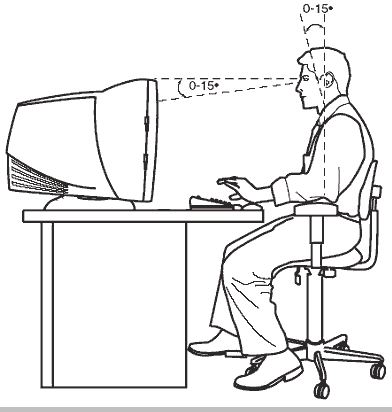Adjusting Your Monitor
Maintaining the correct monitor height will prevent many problems with your eyes, neck and upper back. A monitor improperly positioned can irritate neck musculature, alter the normal spinal curves, induce eyestrain and even initiate migraine headaches.

Call Dr. Zilahy today in
Watertown at
or Waterbury at
Proper monitor placement is very important
![]() Monitor Distance – The monitor should be located directly in front of the area where you’re positioned to view the monitor. The preferred distance from your eyes to the actual screen varies with the size of the monitor and the current resolution settings. A 17 inch monitor should be located no less than 20 inches away. For smaller monitors you may need to be a little closer and for larger monitors a little farther away.
Monitor Distance – The monitor should be located directly in front of the area where you’re positioned to view the monitor. The preferred distance from your eyes to the actual screen varies with the size of the monitor and the current resolution settings. A 17 inch monitor should be located no less than 20 inches away. For smaller monitors you may need to be a little closer and for larger monitors a little farther away.
![]() Monitor Settings – In conjunction with setting up the ideal distance between you and your monitor you may additionally need to alter the monitors resolution, contrast and brightness settings. This will allow characters and images to display clearly preventing squinting and eyestrain. The settings will vary depending on the distance you are from the monitor, the background you have on your active screen, the amount and type of lighting at your workstation, and the quality of your vision.
Monitor Settings – In conjunction with setting up the ideal distance between you and your monitor you may additionally need to alter the monitors resolution, contrast and brightness settings. This will allow characters and images to display clearly preventing squinting and eyestrain. The settings will vary depending on the distance you are from the monitor, the background you have on your active screen, the amount and type of lighting at your workstation, and the quality of your vision.
![]() Lighting and Glare – Improperly positioned lighting can also wreak havoc on your ability to comfortably view your monitors display. Solutions include moving your monitor, moving the lighting, closing blinds or curtains, adjusting your monitors brightness setting, installing an anti-glare screen on your monitor, changing your background color to a lighter color, or even taping paper or cardboard along the edges of the monitor to act as a “visor”.
Lighting and Glare – Improperly positioned lighting can also wreak havoc on your ability to comfortably view your monitors display. Solutions include moving your monitor, moving the lighting, closing blinds or curtains, adjusting your monitors brightness setting, installing an anti-glare screen on your monitor, changing your background color to a lighter color, or even taping paper or cardboard along the edges of the monitor to act as a “visor”.
![]() Monitor Height – The proper monitor height is vital in preventing gradual neck and upper back strain. The most effective way to determine correct monitor height is to sit correctly in your chair or where ever you view your monitor. Next, close your eyes and position your body and head in a neutral and comfortable position – your spine should be straight and head centered over your shoulders. Then, open your eyes and note at which point your eyes are initially focused on. This area should correlate to the center of your monitors screen or the part of the screen you view most frequently.
Monitor Height – The proper monitor height is vital in preventing gradual neck and upper back strain. The most effective way to determine correct monitor height is to sit correctly in your chair or where ever you view your monitor. Next, close your eyes and position your body and head in a neutral and comfortable position – your spine should be straight and head centered over your shoulders. Then, open your eyes and note at which point your eyes are initially focused on. This area should correlate to the center of your monitors screen or the part of the screen you view most frequently.
